Crum Woods Chronicle: Catch a Falling Leaf
This article is part of an ongoing column called the Crum Woods Chronicle. The Crum Woods Chronicle will be periodic updates and observations about subjects related to natural history, interesting species found in and around the Crum Woods, and exciting events you can get involved in. My hope is that some of these topics will interest you, strengthen your connection to the Crum Woods, and inspire you to explore your backyard a little more often.
Natural areas do not maintain their character and quality independently, especially when they are heavily used by people and embedded in urban environments. Educating yourself about aspects of the Crum Woods that interest you and understanding how your individual use of the Crum Woods impacts it (and how you can reduce that impact!) are important steps every one of us should take.
“In the end we will conserve only what we love; we will love only what we understand; and we will understand only what we are taught.” –Baba Dioum
Catch a Falling Leaf
by: Kate Crowley ‘16
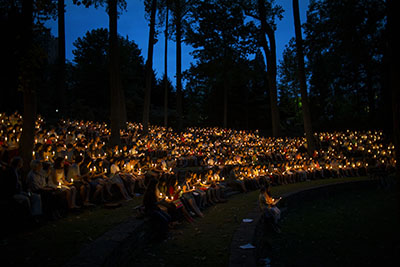
First Collection in the Scott Outdoor Amphitheater on the campus of Swarthmore College. photo credit: L. Kesterson
Three weeks ago the class of 2019 gathered in the amphitheater for First Collection. Less than nine months from now, the class of 2016 will sit together in the same place for our Commencement ceremony. The amphitheater is where we symbolically begin and end our time at Swarthmore. Situated at the border between the Crum Woods and campus, it is a place of peaceful transition. Our first introduction to campus and our last goodbye feel humane because of the solid rock beneath us and powerful trees above us. As a literal transition from campus, the Crum Woods seem so much more approachable when you begin by meandering through the amphitheater and picking up one of the many trails behind the stage.
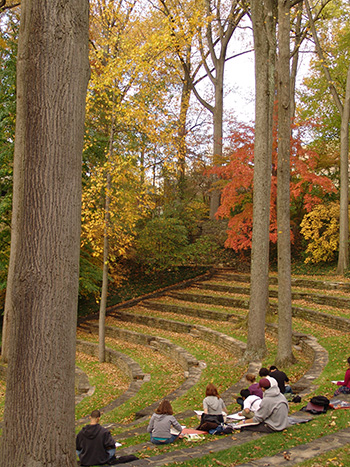
The tall, statuesque trees dotting the amphitheater are tulip trees (Liriodendron tulipifera). photo credit: R. Maurer
The tall, statuesque trees dotting the amphitheater are tulip trees (Liriodendron tulipifera). Tulip trees are not closely related to the bulbous flower of the same name. Rather, they have leaves that look somewhat like two-dimensional tulip flowers and tulip-like flowers in the spring. The tulip trees in the amphitheater were conserved during the amphitheater’s construction because they are fast-growing (more than 24 inches a year!) and reach heights of up to 120 feet (36.5 m), providing an impressive canopy.
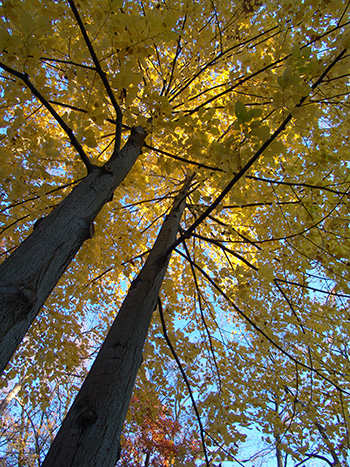
Tulip trees are often used as telephone poles due to their strong apical growth, which is a technical term that means the tree grows up, rather that out. photo credit: R. Robert
You might not have realized it, but if you’ve spent much time on the east coast you’ve probably encountered tulip trees in a number of other places! Tulip trees are often used as telephone poles due to their strong apical growth, which is a technical term that means the tree grows up, rather that out. If you take a minute to look out the window from where you’re reading this, the leaves being puppeted around by the wind are most likely from tulip trees. They’re great to chase and try to catch.
While tulip trees are native to the northeast, it is likely that they weren’t always so abundant. Much of the land in Pennsylvania and surrounding areas of the country was heavily farmed. Because tulip trees spread their seeds through wind dispersal, they had little difficulty continuing to reproduce and regenerate. However, other tree species that rely on animals to carry seeds would have been less successful in such a landscape. Birds and mammals may have had smaller populations in open and heavily managed areas, leading to reduced regeneration of trees that used that strategy. Now, in more urban environments, tulip trees may experience a similar advantage.
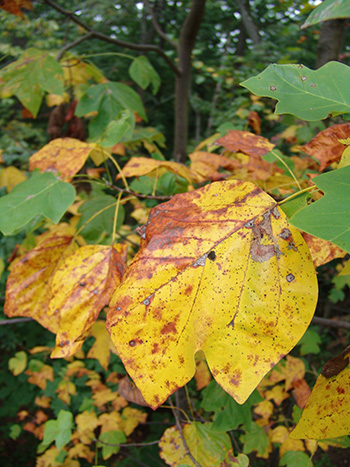
Tulip trees have leaves that look somewhat like two-dimensional tulip flowers and tulip-like flowers in the spring. photo credit: R. Robert
In a few weeks, tulip tree leaves are going to turn a vibrant yellow. There is no better place to appreciate autumn on our campus than in the amphitheater and on into the Crum Woods. I guarantee it will be a perfect place to take a photo and show your friends back home how #gorgeous your campus is.

There is no better place to appreciate autumn on our campus than in the amphitheater and on into the Crum Woods. photo credit: R. Robert
If you want to see a particularly impressive specimen, our very own Crum Woods is home to a Pennsylvania Champion Tree. It is the fourth biggest tulip tree in Pennsylvania, pulling in 373 “Pennsylvania Big Tree Points” (height (ft) + circumference breast height (in) + ¼ maximum crown spread). Find the trail that starts at the water tower behind the Science Center, and walk downhill. Just where the trail starts to veer left, look straight ahead into the woods. It’s rather treasured by the Scott Arboretum and other tree enthusiasts so the best thing you can do is stay on the trail and admire from afar. Happy leaf catching!
Kate Crowley, Swarthmore Class of 2016, is the 2015 – 2016 Crum Woods Chronicler. A native of Melbourne, FL and currently majoring in Biology and Educational Studies, Kate is interested in the way the public learns about science and how we can strengthen our connection to natural places. She has enjoyed running and walking through the Crum Woods over the years and hopes to share her appreciation with others.





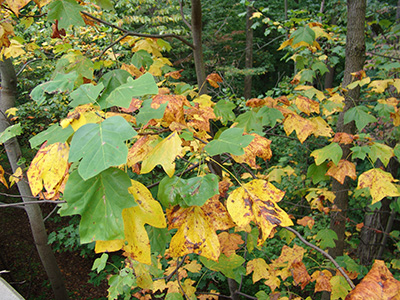
No Comments